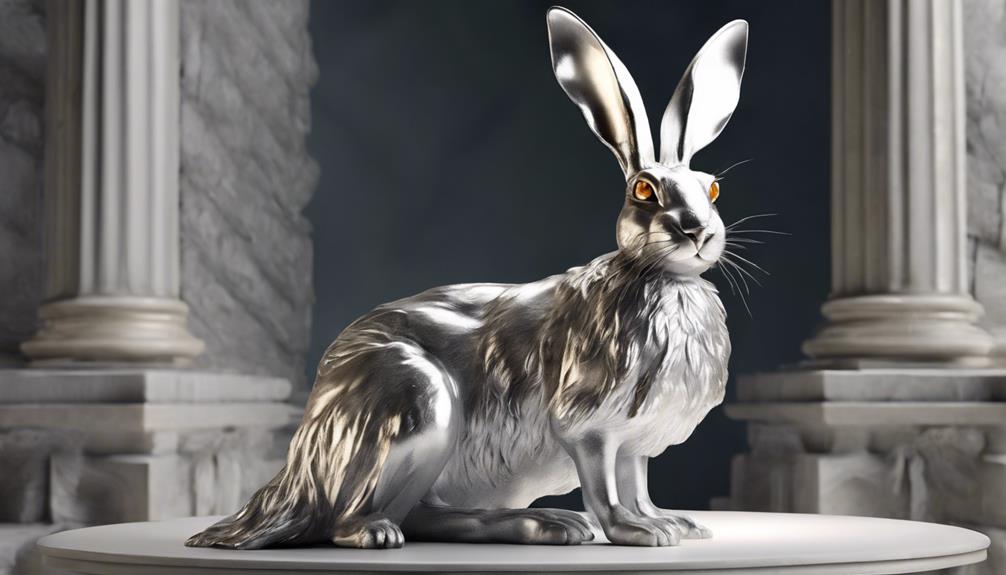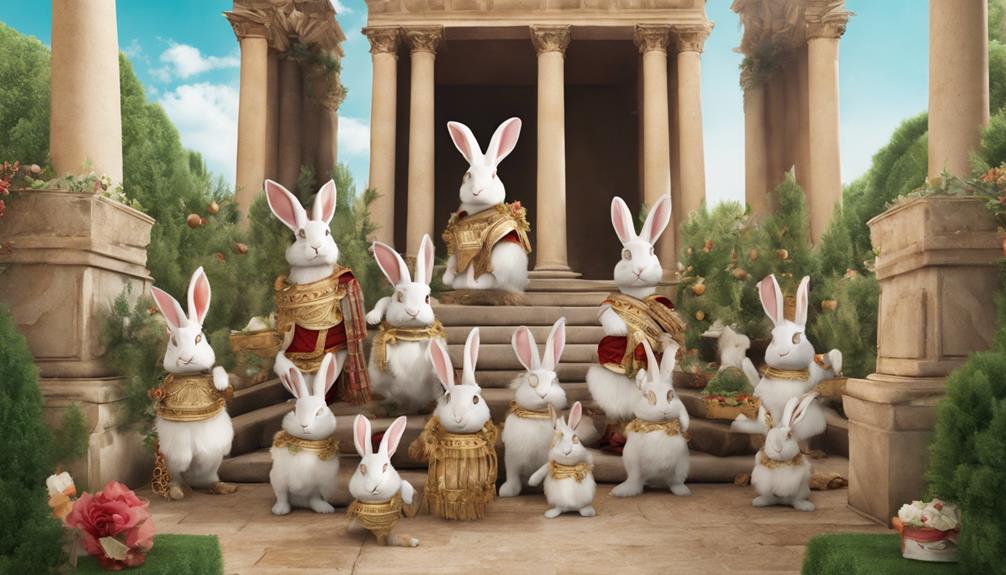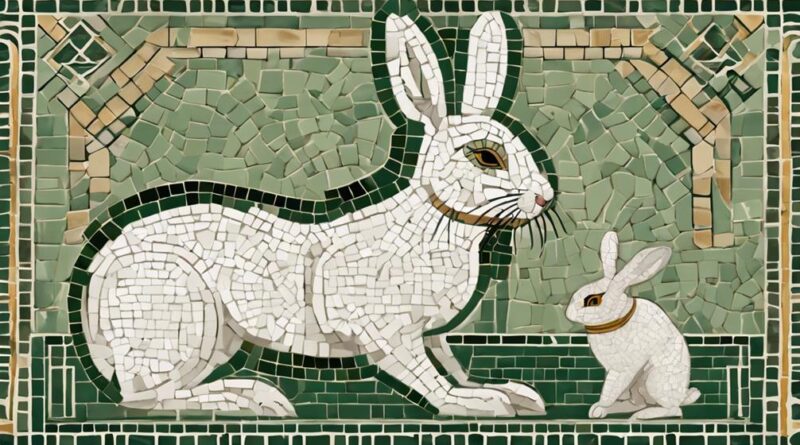10 Best Examples of Rabbits in Ancient Cultures
Explore ancient cultures to see how rabbits symbolized fertility, rebirth, and prosperity. Egyptian goddesses celebrated rabbits for their ties to new life and renewal, while Aztecs used them in rituals honoring gods and balancing society. Chinese beliefs viewed moon rabbits as symbols of introspection and good fortune. In Celtic folklore, rabbits embodied growth and interconnectedness. Greek myths showcased hares for their cunning and swiftness. Additional examples include lucky rabbit charms in Japanese culture, Roman festivals symbolizing renewal, and Norse folklore associating rabbits with luck. Aboriginal Dreamtime bunnies reflected harmony with nature and respect for all beings.
Egyptian Rabbit Goddesses
In ancient Egyptian mythology, the rabbit goddesses were revered for their connection to fertility and abundance. These divine rabbits were seen as symbols of fertility and new life, embodying the cyclical nature of birth, growth, and rebirth. One of the most notable representations of this fertility symbolism is the concept of the Sacred Hare in ancient Egypt.
The Sacred Hare was a significant figure in Egyptian religious beliefs, often associated with deities such as Osiris, the god of the afterlife, regeneration, and rebirth. The hare's ability to reproduce quickly and abundantly made it a powerful symbol of fertility and prosperity. As a result, the rabbit goddesses were often depicted with attributes related to fertility, such as symbols of grain and abundance.
In Egyptian art and mythology, the rabbit goddesses were portrayed with great care and attention to detail, showcasing their importance in the religious and cultural beliefs of the time. These depictions served to reinforce the connection between the divine rabbits and the concepts of fertility, growth, and renewal that were highly valued in ancient Egyptian society.
Aztec Rabbit Sacrifices
The cultural practices of the Aztecs involved significant rituals and sacrifices, including those concerning rabbits as offerings. In Aztec society, rabbits held ritual significance and were used in sacrifice rituals as part of their cultural beliefs and spiritual practices. The Aztecs believed in a complex system of deities, where different animals, including rabbits, represented specific gods or had symbolic meanings tied to their spiritual beliefs.
Rabbits were considered sacred animals in Aztec culture, often associated with fertility, abundance, and the cycles of life and death. They were believed to have a connection to the natural world and the supernatural realm, making them suitable candidates for sacrifices in various ceremonies. These sacrifice rituals involving rabbits were conducted to honor the gods, seek their favor, or ensure the well-being of the community.
The Aztecs saw the act of sacrifice as a way to maintain the balance between the earthly realm and the divine world. By offering rabbits as sacrifices, they believed they could communicate with the gods, express gratitude, or ask for blessings in times of need. The intricate rituals surrounding rabbit sacrifices were deeply ingrained in Aztec society, reflecting the importance of these practices in their cultural and spiritual traditions.
Chinese Moon Rabbit Beliefs
Symbolizing introspection and enlightenment, Chinese Moon Rabbit Beliefs intertwine folklore with celestial symbolism. In Chinese culture, the Moon Rabbit is a prominent figure in Moon rabbit legends and Lunar mythology traditions. The legend of the Moon Rabbit dates back thousands of years and is deeply rooted in Chinese folklore.
According to the myth, there's a rabbit that lives on the moon, pounding medicine with a mortar and pestle. This imagery symbolizes the rabbit's selfless nature and its dedication to helping others. The Moon Rabbit is often associated with immortality, wisdom, and benevolence, making it a revered symbol in Chinese culture.
In Lunar mythology traditions, the Moon Rabbit is believed to be a companion to the Moon Goddess Chang'e. Together, they represent the balance between light and dark, yin and yang, in the lunar cycle. The Moon Rabbit's presence on the moon is seen as a sign of good fortune and prosperity, bringing luck to those who gaze upon it.
Celtic Rabbit Symbolism
Celtic Rabbit Symbolism intertwines ancient folklore with nature's mysteries, offering a unique perspective on the significance of rabbits in Celtic culture. In Celtic rabbit folklore, these creatures were often associated with the Otherworld, a realm beyond the physical where magical beings resided. Rabbits were believed to act as messengers between worlds, bridging the gap between the earthly realm and the spiritual realm. This symbolic role of rabbits in Celtic mythology highlights their perceived connection to the supernatural and their representation of fertility and abundance.
The symbolism of rabbits in Celtic art is prevalent, with intricate designs featuring these creatures in various contexts. Often depicted alongside other Celtic symbols like knots and spirals, rabbits were portrayed as symbols of growth, transformation, and the cyclical nature of life. Today, modern interpretations of Celtic rabbit symbolism often focus on themes of rebirth, renewal, and the interconnectedness of all living beings.
The contemporary relevance of Celtic rabbit symbolism can be seen in how these ancient beliefs are still cherished and integrated into modern practices. Many individuals drawn to Celtic heritage find inspiration in the symbolism of rabbits, incorporating these motifs into art, jewelry, and even tattoos as a way to connect with the rich cultural legacy of the Celts. The enduring appeal of Celtic rabbit symbolism serves as a reminder of the enduring power of folklore and myth in shaping our understanding of the world.
Greek Hare in Mythology

In ancient Greek mythology, the hare played a significant role as a symbol of cunning and swiftness, embodying traits associated with various deities and legends. Mythological connections reveal the hare's presence in the story of the goddess Hecate, who was often depicted with a hare by her side. Hecate, associated with magic, crossroads, and the moon, shared the hare's attributes of quick movement and keen senses. The Greek hare also appeared in the myth of Adonis, the god of beauty and desire. Adonis was known to be a skilled hunter, and the hare's speed and agility mirrored his prowess in the hunt.
The symbolism of the hare in ancient cultures extended beyond mythology. The animal's representation of fertility and abundance tied it to deities like Aphrodite, the goddess of love. The hare's ability to reproduce quickly linked it to concepts of renewal and the cycles of life. In Greek art, the hare often symbolized the changing seasons and the regenerative powers of nature.
Japanese Lucky Rabbit Charms
Japanese culture features an array of lucky rabbit charms that hold significant cultural and symbolic value. In Shinto traditions, rabbits are seen as sacred animals symbolizing good fortune, fertility, and protection. The connection between rabbits and luck can be traced back to ancient Japanese folklore, where rabbits are often depicted as magical creatures capable of bringing blessings and prosperity to those who encounter them.
One prominent example of rabbit symbolism in Shinto traditions is the belief in the 'moon rabbit.' This folklore tale involves a rabbit that lives on the moon, pounding mochi (rice cakes) with a mortar and pestle. The image of the moon rabbit is associated with the Japanese Mid-Autumn Festival, known as Tsukimi, where people offer mochi and other foods to honor the rabbit's presence on the moon.
In Japanese rabbit folklore traditions, there's a popular belief that carrying a rabbit foot or owning a rabbit figurine can bring good luck and protect against evil spirits. These charms are often used in homes, businesses, and even worn as jewelry to attract positive energy and ward off negativity.
Roman Rabbit Festivals

Numerous ancient Roman festivals prominently featured rabbits as symbols of fertility and abundance in their cultural celebrations. Rabbits held a significant place in Roman mythology and were often associated with the goddess of fertility, Flora. One of the most famous Roman festivals where rabbits played a central role was the celebration of Floralia, dedicated to Flora. During this festival held from April 28 to May 3, rabbits were seen as sacred animals symbolizing the rebirth and renewal of life in the spring season.
The festive traditions surrounding Roman rabbit festivals were elaborate and colorful. People adorned their homes and temples with rabbit-themed decorations, and it was common to see individuals wearing rabbit masks and costumes during the festivities. Rabbit-shaped sweets and treats were prepared and shared among the community as part of the celebrations.
The cultural significance of rabbits in Roman festivals extended beyond just symbolizing fertility. They were also believed to bring luck and prosperity to the people participating in the festivities. The presence of rabbits in these celebrations highlighted the Romans' deep-rooted connection to nature and their reverence for the cycles of life and abundance. Through these festivals, rabbits became enduring symbols of joy, growth, and prosperity in ancient Roman culture.
Inca Rabbit Cosmology
Rabbits held a unique and significant role in Inca cosmology, reflecting intricate beliefs and connections to the natural world. Inca rabbit symbolism was deeply intertwined with their cosmological views, where the rabbit symbolized abundance, fertility, and the cycles of life. The Andean rabbit rituals were central to honoring Pachamama, the Inca earth mother goddess, as well as Inti, the sun god.
In Inca mythology, the rabbit was considered a sacred animal representing prosperity and rebirth. The Andean people believed that rabbits had the ability to communicate with the spiritual realm and bring messages from the gods. This reverence for rabbits extended to their agricultural practices, where the presence of rabbits in fields was seen as a sign of good fortune and a bountiful harvest to come.
Furthermore, the Inca rabbit symbolism wasn't limited to material abundance but also encompassed spiritual wealth. The Andean rabbit rituals involved offerings and ceremonies dedicated to the rabbits to ensure the well-being of the community and the balance of the natural world. By honoring the rabbits in their cosmology, the Inca people sought to maintain harmony with nature and the divine forces that governed their lives.
Norse Rabbit Folklore

In exploring the cultural significance of rabbits across different ancient societies, Norse Rabbit Folklore emerges as a fascinating realm of mythology and symbolism. In Norse mythology, rabbits weren't mere woodland creatures but held significant symbolic and magical properties. The Norse rabbit symbolism often intertwined with notions of fertility, abundance, and cunning intelligence.
Rabbit folklore in Scandinavian tales frequently depicted these creatures as companions to powerful deities like Freyja, the goddess of love and fertility. Rabbits were believed to bring good luck and prosperity to those who honored them. Moreover, their association with Freyja added layers of mystery and allure to their presence in Norse mythology.
The magical properties attributed to rabbits in Norse folklore extended beyond their physical characteristics. They were believed to possess the ability to traverse between worlds, acting as messengers between the earthly realm and the divine. This mystical quality added depth to their portrayal in stories and made them central figures in many myths and legends.
Aboriginal Dreamtime Bunny Folktales
Aboriginal Dreamtime Bunny Folktales hold profound cultural significance within the rich tapestry of Australian indigenous narratives. Dreamtime storytelling plays a crucial role in Aboriginal culture, serving as a way to pass down traditions, beliefs, and customs from one generation to the next. Within these tales, bunnies are often portrayed as clever and resourceful characters, embodying traits that are admired and valued in Aboriginal communities.
In Aboriginal art, the symbolism interpretation of bunnies varies across different regions. Some artworks depict bunnies as symbols of fertility and abundance, while in other instances, they represent cunning and intelligence. These interpretations highlight the diverse perspectives and meanings attributed to bunnies in Aboriginal Dreamtime Bunny Folktales.
Furthermore, the portrayal of bunnies in Aboriginal Dreamtime stories reflects the deep connection that Indigenous Australians have with the land and its creatures. Bunnies are often depicted as guardians of the natural world, emphasizing the importance of living in harmony with nature and respecting all living beings.
Frequently Asked Questions
How Were Rabbits Incorporated Into Inca Cosmology?
In Inca cosmology, rabbits were significant in rituals and symbolism. They held a place in folklore and myths, often representing fertility, abundance, and connection to the natural world.
Incorporating rabbits into their beliefs showcased the Inca's reverence for nature and the cycles of life. Through various ceremonies and stories, rabbits played a vital role in shaping the spiritual practices of the Inca civilization, emphasizing the interconnectedness between humans and the environment.
What Is the Significance of Rabbits in Celtic Symbolism?
In Celtic symbolism, rabbits hold diverse meanings. They're often associated with fertility, rebirth, and agility.
The rabbit's ability to burrow underground connects it to the Otherworld in Celtic beliefs. This creature symbolizes quick thinking and cleverness in Celtic folklore.
Additionally, rabbits are linked to the lunar cycle and the concept of growth and renewal.
Why Were Rabbits Associated With the Moon in Chinese Beliefs?
In Chinese lunar symbolism, rabbits were associated with the moon due to the Moon Hare mythology. This belief stems from ancient Chinese folklore where a rabbit was said to live on the moon, pounding elixirs of immortality.
The hare's connection to the moon represented longevity, fertility, and the yin principle in Chinese cosmology. This association between rabbits and the moon in Chinese beliefs reflects deep-rooted cultural and spiritual significance.
What Were the Rituals Involved in Aztec Rabbit Sacrifices?
In Aztec rituals, blood sacrifices were a significant part of their cultural beliefs. Rabbit symbolism played a role in these ceremonies, where rabbits were sometimes used as offerings to the gods.
The Aztecs believed that sacrificing animals, including rabbits, appeased the deities and ensured prosperity and protection for their people. These rituals were deeply ingrained in Aztec society and played a crucial role in their religious practices.
How Did the Norse Incorporate Rabbits Into Their Folklore?
In Norse folklore, rabbits were often associated with fertility, agility, and cunning. They appeared in tales depicting them as clever creatures that outsmarted predators. Rabbit symbolism in Norse mythology symbolized quick thinking and survival skills.
The stories featuring rabbits served as moral lessons for individuals on the importance of wit and resourcefulness in overcoming challenges. This portrayal of rabbits in Norse folklore contributed to their enduring presence in ancient Norse tales.
Conclusion
In conclusion, rabbits have played a significant role in various ancient cultures, serving as symbols of fertility, sacrifice, and even cosmological beliefs.
From Egyptian rabbit goddesses to Aztec rabbit sacrifices, these creatures have left a lasting impact on the cultural and mythological beliefs of societies around the world.
By examining the diverse ways in which rabbits were revered and incorporated into ancient traditions, we gain a deeper understanding of the significance these animals held in the collective imagination of humanity.
